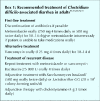Clostridium difficile-associated diarrhea in adults
- PMID: 15238498
- PMCID: PMC437686
- DOI: 10.1503/cmaj.1031189
Clostridium difficile-associated diarrhea in adults
Abstract
Clostridium difficile is the most important cause of nosocomial diarrhea in adults. Illness may range from mild watery diarrhea to life-threatening colitis. An antecedent disruption of the normal colonic flora followed by exposure to a toxigenic strain of C. difficile are necessary first steps in the pathogenesis of disease. Diagnosis is based primarily on the detection of C. difficile toxin A or toxin B. First-line treatment is with oral metronidazole therapy. Treatment with oral vancomycin therapy should be reserved for patients who have contraindications or intolerance to metronidazole or who fail to respond to first-line therapy.
Figures



Comment in
-
Clostridium difficile: a formidable foe.CMAJ. 2004 Jul 6;171(1):47-8. doi: 10.1503/cmaj.1040836. CMAJ. 2004. PMID: 15238496 Free PMC article. No abstract available.
-
Treating C. difficile.CMAJ. 2005 Feb 15;172(4):447-8. doi: 10.1503/cmaj.1041646. CMAJ. 2005. PMID: 15710916 Free PMC article. No abstract available.
-
Treating C. difficile.CMAJ. 2005 Feb 15;172(4):448; author reply 448. doi: 10.1503/cmaj.1041195. CMAJ. 2005. PMID: 15710921 Free PMC article. No abstract available.
References
-
- Hall IC, O'Toole E. Intestinal flora in newborn infants with a description of a new pathogenic anaerobe, Bacillus difficilis. Am J Dis Child 1935;49:390-402.
-
- Larson HE, Price AB, Honour P, Borriello SP. Clostridium difficile and the aetiology of pseudomembranous colitis. Lancet 1978;1:1063-6. - PubMed
-
- Hyland M, Ofner-Agostini ME, Miller MA, Paton S, Gourdeau M, Ishak M. Nosocomial Clostridium difficile-associated diarrhea in Canada: the results of the Canadian Nosocomial Infection Surveillance Program (CNISP) 1997 N-CDAD prevalence surveillance project. Can J Infect Dis 2001;12:81-8. - PMC - PubMed
Publication types
MeSH terms
Substances
LinkOut - more resources
Full Text Sources
Other Literature Sources
Medical
